Polyline Tools
 Toolbar : Polyline Tools
Toolbar : Polyline Tools 
Menu : GeoTools -> Polyline Tools -> Join -> Join 3D Polylines  CmdLine : GT_3DJ
CmdLine : GT_3DJ
The GT_3DJ command joins 3D segments (lines or polylines) combines them into a 3D polyline. The PEDIT command does not allow joining of 3D segments. This command fills the need by allowing the Join sub command to be applied on 3D polyline segments or lines. The segments to be joined must be exactly touching each other.
Once the command has been issued, the prompts that follow are similar to the PEDIT command. You are prompted to select polylines. If a line has been selected, you are prompted to convert it into a polyline. Then you select the objects to join. All touching segments are joined to the first segment resulting in a joined 3D Polyline.
Select 3d polylines/lines to join (or ENTER to select by layer[s]):
Select objects: (do so)

If you are selecting multiple layers for processing, GT_3DJ will join them individually in their respective layers. They will not be joined across different layers except if they are selected explicitly from the command line.
 Toolbar : Polyline Tools
Toolbar : Polyline Tools ![]()
Menu : GeoTools -> Polyline Tools -> Join -> Automated Join 2D Polylines  CmdLine : GT_PLJOIN
CmdLine : GT_PLJOIN
The GT_PLJOIN command automatically fuses (joins) all selected line or polyline objects together. The objects should be touching each other at their ends.
 Toolbar : Polyline Tools
Toolbar : Polyline Tools 
Menu : GeoTools-> Polyline-> Change 2d->3d->2d-> 2D-to-3D CmdLine : GT_CH2D3D
CmdLine : GT_CH2D3D
The GT_CH2D3D command converts all the selected 2D Polylines to 3D polylines. A 3D polyline can hold different Z values in each vertex. The new 3D polylines thus formed will look exactly like the 2D polylines except that internally they are 3D and therefore can hold Z values.
The standard object selection dialog appears and allows polylines and lines to be selected. Click Apply and all the 2D polylines are converted into 3D polylines. The original 2D polyline will be erased.
Tech Info: GT_CH2D3D changes the DXF Group Code 70 of each polyline, adds the 8 bit and recreates a 3D polyline. The 3D polyline thus created has the 3D flag set. The 3D polyline acquires new handles but any extended entity data in the 2D polyline will be transferred to the 3D polyline.
Watch: ![]()
 Toolbar : Polyline Tools
Toolbar : Polyline Tools 
Menu : GeoTools -> Polyline Tools -> Change 2d->3d->2d -> 3D-to-2D CmdLine : GT_CH3D2D
CmdLine : GT_CH3D2D
The GT_CH3D2D command converts all selected 3D polylines and lines into 2D polylines and lines. Depending on the setting of the PLINETYPE variable, the 2D polylines thus formed will be either heavy weight polylines or light weight polylines.
While creating the 2d polylines, you can specify the constant elevation that the 2d polylines should acquire.
The following options are possible:
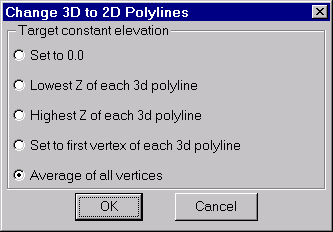
The standard object selection dialog appears and allows polylines and lines to be selected.
Click Apply and the all the 3D polylines and lines are converted into 2D polylines. The original 3D polyline will be erased.
Tech Info: GT_CH3D2D changes the DXF Group Code 70 of each polyline, removes the 8 bit and recreates a 2D polyline. The 2D polyline acquires new handles but any extended entity data in the 3D polyline will be transferred to the 2D polyline.
Watch: ![]()
 Toolbar : Polyline Tools
Toolbar : Polyline Tools 
Menu : GeoTools -> Polyline Tools -> Optimization/Cleanup -> Densify Vertices CmdLine : GT_DENSIFY
CmdLine : GT_DENSIFY
The GT_DENSIFY command can be used to add extra vertices to the polylines, i.e. 2D or 3D based on the "Number of segments" and "Length of segment"
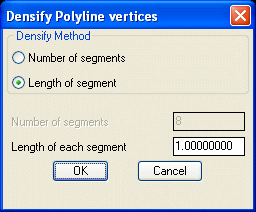
Densify Method
Number of segments: Densifies or adds vertices with specified number of segments.
Length of segment: Densifies or adds vertices with specified length i.e. distance between each vertices.
Tech Info: GT_DENSIFY will not work on polylines containing arc segments. Such polylines will be ignored by the GT_DENSIFY command and must be pre-processed using other GeoTools commands before they can be densified.
 Toolbar : Polyline Tools
Toolbar : Polyline Tools 
Menu : GeoTools -> Polyline Tools -> Optimization/Cleanup -> Weed (Remove) collinear vertices from polyline CmdLine : GT_REM_LINVERTS
CmdLine : GT_REM_LINVERTS
The GT_REM_LINVERTS command removes collinear vertices from polylines. Any three vertices which fall in a straight line are said to be collinear and will be be removed.

Mark locations of removed vertices with points: Checking this box marks points at the location where the linear vertices were removed.
 Toolbar : Polyline Tools
Toolbar : Polyline Tools 
Menu : GeoTools -> Polyline Tools -> Vertex Management-> Add/Remove redundant closing vertex in polyline CmdLine : GT_FIXCLOSED
CmdLine : GT_FIXCLOSED
The GT_FIXCLOSED command helps to add or remove the redundant last vertex of a closed polyline. In other words, this command adds or removes the duplication of the last vertex in closed polylines, which may sometimes be desirable and sometimes not.
Add Closing Vertex
Adds a redundant "last" vertex to closed polylines. This duplicates the first and last vertex of a closed polyline. The new vertex is added only if the distance between the first and last vertex is greater than the closing tolerance specified in the dialog box above.
Remove Closing Vertex
Removes the last vertex from the polyline if the distance between the first and last vertex is less than the value specified in the dialog box above.
Toolbar : Polyline Tools 
Menu : GeoTools -> Polyline Tools -> Vertex Management -> Place Points/Blocks along vertices CmdLine : GT_PL_PLACE
CmdLine : GT_PL_PLACE
 Toolbar : Polyline Tools
Toolbar : Polyline Tools 
Menu : GeoTools -> Polyline Tools -> Vertex Management -> Delete single vertex polylines CmdLine : GT_DELSVP
CmdLine : GT_DELSVP
The GT_DELSVP command deletes a single vertex or zero-length polyline from the selected objects. Unlike the GT_0LEN2PNT command which creates a point at every location of a zero-length polyline, this command will delete it from the drawing.
 Toolbar : Polyline Tools
Toolbar : Polyline Tools 
Menu : GeoTools -> Polyline Tools -> Optimization/Cleanup -> Weed (remove) vertices based on distance and angle CmdLine : GT_DISTANGWEED
CmdLine : GT_DISTANGWEED
The GT_DISTANGWEED command can be used to eliminate redundant vertices in a polyline by weeding out vertices that fall closer than a specified value or those segments that deflect less than a given angular value. There is also an option to create a point object at every location where a vertex was weeded.
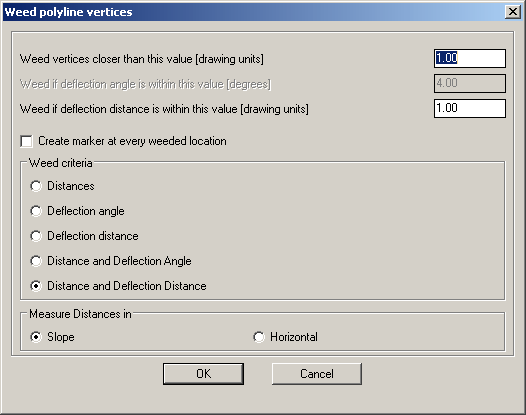
Weed vertices closer than this value [drawing units]:
Enter the linear tolerance parameter here. This is specified in drawing units. Any two consecutive vertices that are closer (nearer) than this value will result in the second vertex to be removed. Weed if deflection angle is within this value [degrees]:
Enter the angular tolerance parameter value in degrees.
Create marker at every weeded location:
Checking this box creates a POINT object marker at every vertex location that was weeded. This helps in identifying the locations where the weeding took place.
Weed criteria
Distances: Checking this option causes weeding based on inter-vertex distance only.
Deflection angle: Checking this option causes weeding based on deflection angle only.
Deflection distance: Checking this option causes weeding based on deflection distances only. Deflection distance and angle: Checking this option causes weeding based on both deflection distance and deflection angle. tance and deflection distance: Checking this option causes weeding based on both inter-vertex distances and deflection distance.
Measure distances in: Slope: Checking this option measures slope (actual) distances.
Horizontal: Checking this option measures horizontally projected distances.
Tech Info: Polylines containing ARC segments will be weeded based on their inter-vertex straight line lengths and NOT the actual arc distances. Therefore, in areas where arc segments exist, the results may sometimes not be as desired. You may want to convert the arc segmented polylines to linear segmented polylines using the GT_PLARC2PL command.
 Toolbar : Polyline Tools
Toolbar : Polyline Tools ![]()
Menu : GeoTools -> Polyline Tools -> Optimization/Cleanup -> Weed (Remove) collinear vertices from polyline  CmdLine : GT_REM_LINVERTS
CmdLine : GT_REM_LINVERTS
 Toolbar : Polyline Tools
Toolbar : Polyline Tools 
Menu : GeoTools -> Polyline Tools -> Identify -> Mark intersection points along lines,polylines,arcs CmdLine : GT_INTERSECT
CmdLine : GT_INTERSECT
The GT_INTERSECT command can be used to mark 3d (and 2d) points of intersection between polylines, lines, arcs and/or splines. Please be aware that this command does not mark self-intersections between the segments of the same polyline or spline object. Instead, it marks points where each object intersects with other objects in the selection.
Lines, polylines, arcs, splines and circle are supported for intersection and clash detection functions.
 Toolbar : Polyline Tools
Toolbar : Polyline Tools 
Menu : GeoTools -> Polyline Tools -> Identify -> Find 3d intersections CmdLine : GT_3DINT
CmdLine : GT_3DINT
The GT_3DINT command detects 3d intersection between two entities. Lines, arcs, polylines and splines are supported as valid entities and the two 3d points where they intersect are marked with points and can also be optionally connected by a line.
The inspiration for this program came from users in mapping, mining and geological domains where it is important to determine the crossing or intersections of linear elements. This can also be used by conceptual planning architects and engineers to perform spatial analysis of building elements in a 3D space.
 Toolbar : Polyline Tools
Toolbar : Polyline Tools 
Menu : GeoTools -> Polyline Tools -> Identify -> Mark junction points in a network of linear objects CmdLine : GT_JUNCTION
CmdLine : GT_JUNCTION
The GT_JUNCTION command creates points at every junction node. A junction is defined as a point where at least three or more segments branch out in as many different directions.
Please note that while the GT_INTERSECT command creates points at every segmental intersection, the GT_JUNCTION command creates points at every junction or node where there is an explicit vertex or end point or ARC or LINE.
 Toolbar : Polyline Tools
Toolbar : Polyline Tools 
Menu : GeoTools -> Polyline Tools -> Identify -> Highlight PLINE vertices with 0 elevation  CmdLine : GT_PL_0
CmdLine : GT_PL_0
The GT_PL_0 command identifies vertices in polylines, which have an elevation of 0.0. This is particularly useful to study erring 3d polylines, which have one or a few vertices, whose elevation has fallen to 0.0 because of an erroneous program or due to operator error.
A POINT object is created on a temporary layer at the positions of vertex whose elevation is 0.0
 Toolbar : Polyline Tools
Toolbar : Polyline Tools 
Menu : GeoTools -> Polyline Tools -> Identify -> Highlight elevation differences in polylines CmdLine : GT_VXDROP
CmdLine : GT_VXDROP

The GT_VXDROP command identifies polylines, lines, splines and 3dfaces whose vertex elevation range (difference of maximum and minimum elevations) exceed a specified value. Enter the desired vertex elevation difference into the dialog box shown above.
 Toolbar : Polyline Tools
Toolbar : Polyline Tools 
Menu : GeoTools -> Polyline Tools -> Process -> Assign Interpolated Z values to vertices CmdLine : GT_PL_INTER
CmdLine : GT_PL_INTER
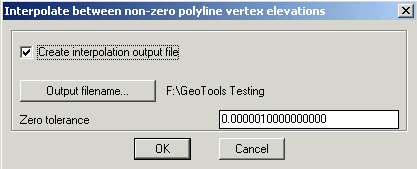
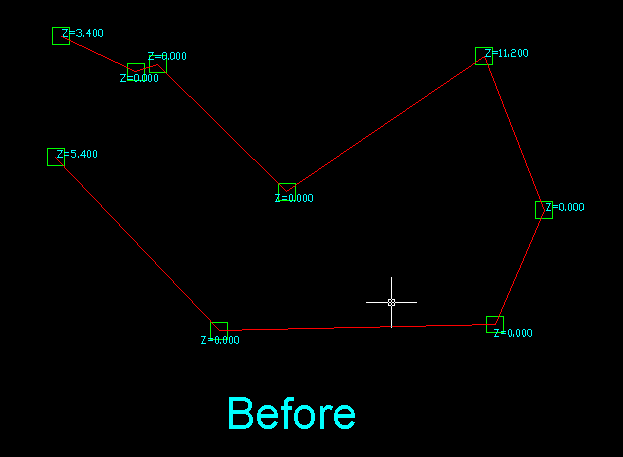
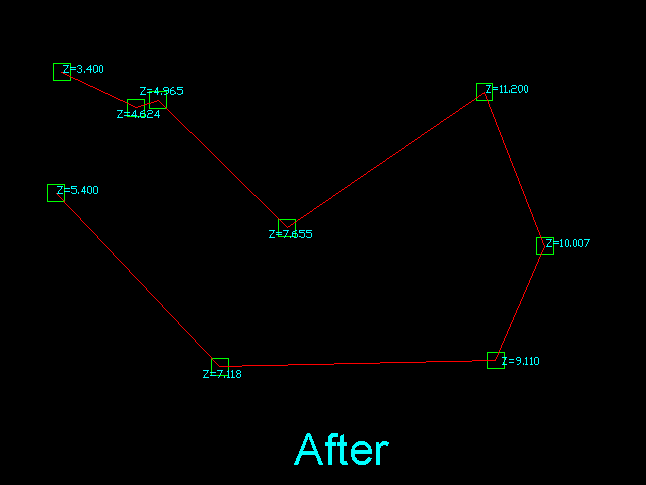
Often, you may have polylines in which some vertices have a zero elevation while others have non-zero elevations. The GT_PL_INTER command fills in all the zero [0.0] elevation vertices with non-zero values based on a linear distance interpolation between the non-zero vertices.
Create interpolation output file: Checking this box creates an .txt output file of interpolation
Output filename...: Click on this button to specify the output file path.
Zero tolerance: Enter the required tolerance value.
Watch: ![]()
 Toolbar : Polyline Tools
Toolbar : Polyline Tools 
Menu : GeoTools -> Polyline Tools -> Process -> Merge adjacent closed polylines  CmdLine : GT_MERGEPOLY
CmdLine : GT_MERGEPOLY
The GT_MERGEPOLY command is used to merge adjacent closed polylines which have overlapping and common boundaries between them. This is a useful tool to process a set of adjacent closed polylines resulting from typical GIS analyses etc. and retain only the outer-most external boundary out of them. For this program to function, there must be overlapping segments between two polygons. If there is no overlapping polylines segments at the boundary, it will not be processed.

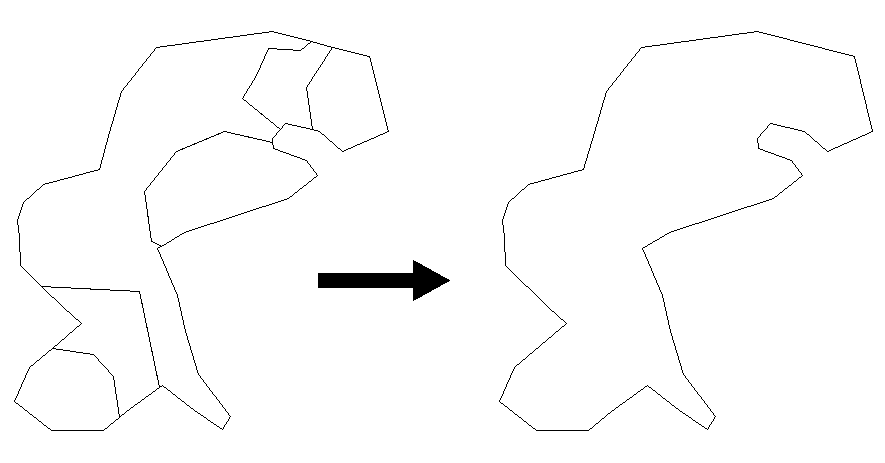
An illustration of what this program does is shown in the image above
 Toolbar : Polyline Tools
Toolbar : Polyline Tools 
Menu : GeoTools -> Polyline Tools -> Process -> Offset closed polylines INwards/OUTwards CmdLine : GT_INOUTOFFSET
CmdLine : GT_INOUTOFFSET
The GT_INOUTOFFSET allows multiple closed polylines to be offsetted INwards or OUTwards with one single command.
Command: GT_INOUTOFFSET
Select Objects: (select polylines to offset)
Offset direction: [ Inwards/Outwards ] <Outwards>: (Type Inwards or Outwards)
Horizontal offset distance : <1.0000>: (Enter horizontal distance to offset)
 Toolbar : Polyline Tools
Toolbar : Polyline Tools 
Menu : GeoTools -> Polyline Tools -> Process -> Polyline 'Insert Vertex' Tool CmdLine : GT_POLYINSVX
CmdLine : GT_POLYINSVX
The GT_POLYINSVX is a handy tool to populate polyline elevations by acquiring them from neighboring point objects. For example, if you have a 3d polyline running near a set of 3d point objects and want the point elevations to be transferred to the 3d polyline, this is an ideal tool. The tool is quite powerful and offers several different ways in which the transfer happens. Read the descriptions of the various options to know more.
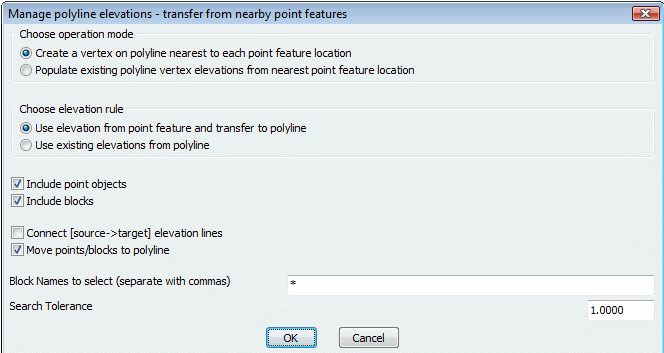

The command requires that you choose a single 3d polyline and a selection of point features (including blocks). New vertices are created in the polyline using one of several methods as explained below.
Choose operation mode
Here, you can choose how the elevations are acquired. You can either create new vertices in the 3d polyline at a location nearest to the selected points -or- have the elevation of the existing vertex of the 3d polyline updated to the elevation of the nearest point around it.
Choose elevation rule
To further refine the earlier operation, you can specify whether the elevation from the point feature is transferred to the new polyline vertex or the elevation of the new vertex is interpolated from the existing elevations of the 3d polyline. The latter is applicable only if the 3d polyline already has valid elevations, in which case the nearby point features only offer the nearest XY location to create a point while the elevation comes from within the 3d polyline.
Include points and/or blocks
It is often possible to have spot heights and point blocks which contain height. This option allows to define the selection filters whether to allow only points, blocks or both in the selection.
Connect [source->target] elevation lines
Checking this option draws a line between the point from which elevation was acquired to the point on the 3d polyline where the elevation was transferred. This is more for checking and verification purposes to ensure that all elevations have been acquired from a valid point. On the other hand, it may sometimes also be necessary to draw this line if you want a design line to be shown as specified.
Move points/blocks to polyline
Checking this option moves the nearby points and blocks to the location of the newly created vertex on the 3d polyline.
Block names to select (separate with commas)
The default is * (all blocks). You can specify the names of the blocks that you want to be processed. Useful in survey and other drawings where there are a number of feature-based blocks and you want to deal with only specific ones.
Search Tolerance
This is perhaps one of the important parameters. The search for nearby points / blocks will be successful only if it is within the distance specified here.
Toolbar : Polyline Tools 
Menu : GeoTools -> Polyline Tools -> Process -> Polyline Transfer corresponding vertex polyline elevations CmdLine : GT_TRANSFER_PLELEV
CmdLine : GT_TRANSFER_PLELEV
Description pending
 Toolbar : Polyline Tools
Toolbar : Polyline Tools 
Menu :GeoTools -> Polyline Tools -> Inquiry & Statistics -> Compute detailed polyline statistics
 CmdLine : GT_PL_STAT
CmdLine : GT_PL_STAT
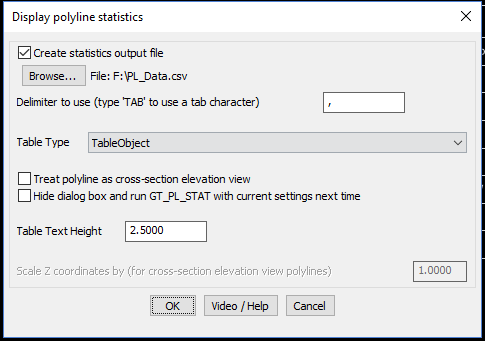
The GT_PL_STAT command generates detailed statistics from a selected polyline. The statistics is reported in three different areas:
- On the command line
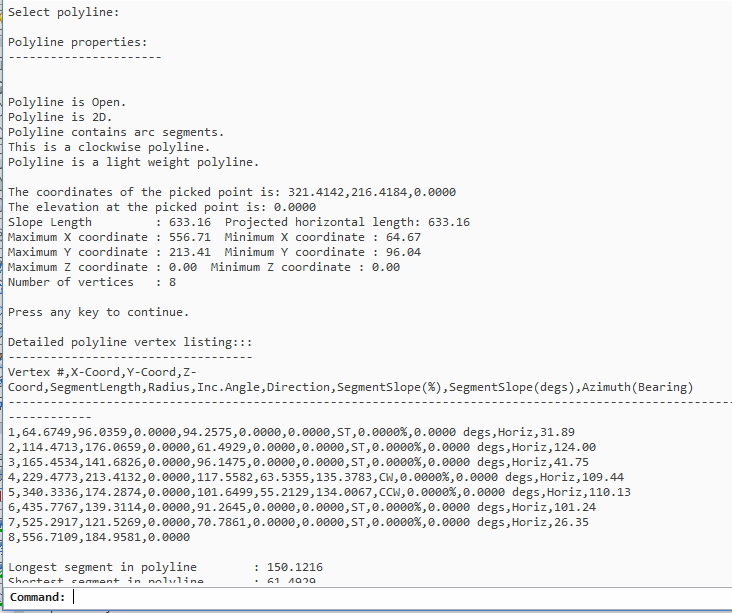
- As a CAD Table
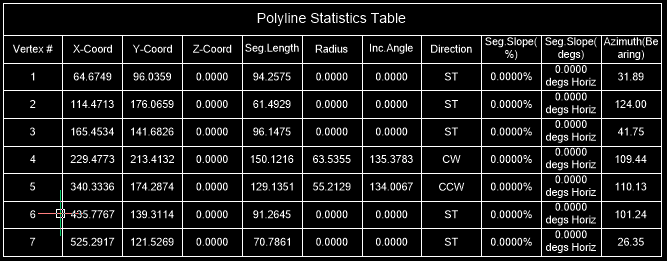
- As CSV files which can be opened in Excel.
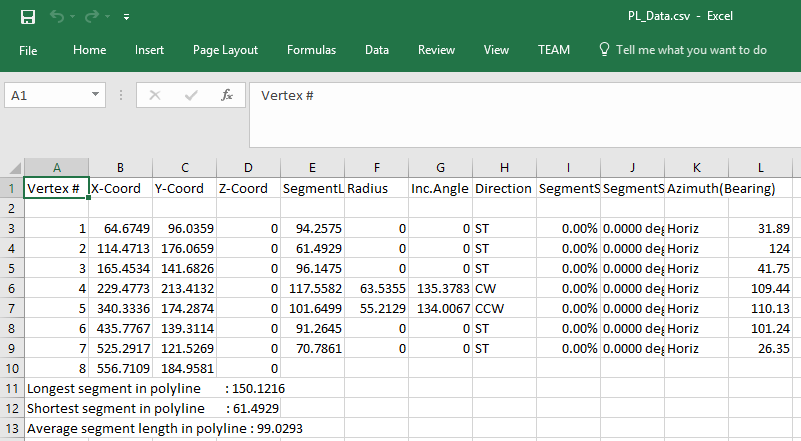
Create output file: Check this option if you want the output from this command to be exported to CSV file which is the native format for Excel.
The contents of the CSV file has been expanded to include the following:
Vertex #,X-Coord,Y-Coord,Z-Coord,SegmentLength,Radius,Inc.Angle,Direction,SegmentSlope(%),SegmentSlope(degs),Azimuth(Bearing)
Browse: Click on this button to select an output file to save the polyline statistics listing
Create tabular output: Creates the polyline statistics in a tabulated form
Table Type: Choose the table type here. The options are CAD Table, Text Table or None.
Treat polyline as elevation view: Checking this option causes the polyline to be treated as elevation view. In other words, the X and Y of the two vertices of the polyline are treated as measurements in the Z plane and the difference between the Y values is taken as the actual elevation difference between the points.
Hide dialog box and run GT_PL_STAT with current settings next time: Checking this option causes GT_PL_STAT to run the next time without dialog box. You will be prompted to only select the polyline to compute statistics and the program operates with the current settings as last set. This setting enables users to run the command quickly without having to navigate through the dialog box each time. The setting remains in place for the current CAD session unless it is reset using the 'GT_SHOWDLG' command.
Table Text Height: Specify the required text height for the contents of table.
Watch: ![]()
![]()
 Toolbar : Polyline Tools
Toolbar : Polyline Tools 
Menu : GeoTools -> Polyline Tools -> Inquiry & Statistics -> Compute summed polyline areas from selected layers CmdLine : GT_LAYERAREA
CmdLine : GT_LAYERAREA
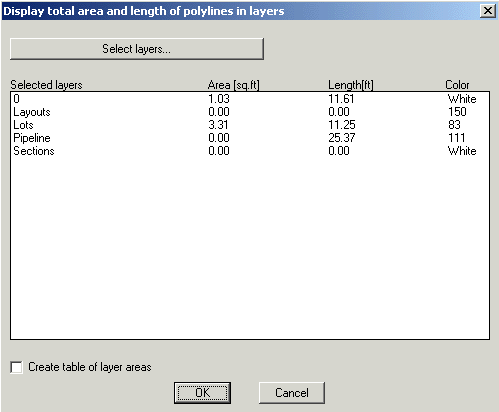
The GT_LAYERAREA command displays the total summed area and length of all polylines in selected layer(s).
Select layers: Clicking on this button displays the complete list of layers in the drawing. From this list, you can select the layers for which you want the total summed areas to be displayed and these will be displayed each time the command starts. Create table of layers areas: Checking this box generates a table of Area, Length and Color of selected layers as shown below.

 Toolbar : Polyline Tools
Toolbar : Polyline Tools 
Menu : GeoTools -> Polyline Tools -> Mode editing -> Multiple Pedit CmdLine : GT_MPEDIT
CmdLine : GT_MPEDIT
GT_MPEDIT is a global Pedit command applied to multiple polylines. The PEDIT command operates on one polyline at a time. GT_MPEDIT can be used to select multiple polylines and process them. It offers the following commands: Open, Close, Fit, Spline, Decurve, Convert to polylines and Change Widths etc.
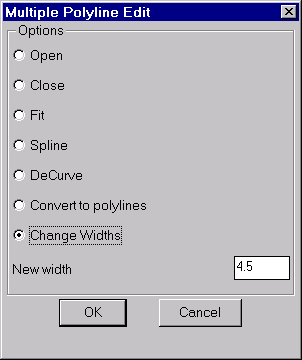
If the Convert to polylines option is chosen, GT_MPEDIT will allow selection of lines, arcs and circles as input data.
If Change Width option is chosen, GT_MPEDIT will allow selection of polylines, lines, arcs and circles as input data.
 Toolbar : Polyline Tools
Toolbar : Polyline Tools 
Menu : GeoTools -> Polyline Tools -> Direction Control -> Flip (Reverse) direction CmdLine : GT_FLIP
CmdLine : GT_FLIP
The GT_FLIP command reverses the direction of the polyline vertices. This command preserves the handle (see below for conditions) as well as any extended entity data that is stored with the polyline or with each or any of its vertices (in case of heavy weight polylines).
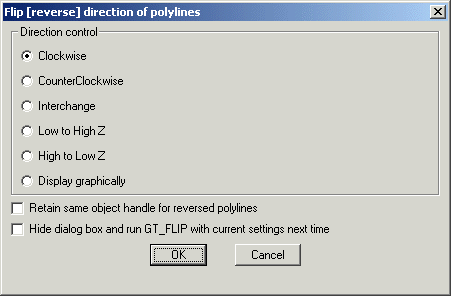
Direction Control:
Clockwise:
Choosing this option flips all counter-clockwise polylines to clockwise
CounterClockwise:
Choosing this option flips all clockwise polylines counter-clockwise
Interchange: Reverses the direction of all selected polylines irrespective of whether they are clockwise or counterclockwise.
Low to High Z:
Reverses the direction of the polylines whose last vertex elevation (Z value) is higher than the first vertex elevation (Z value).
High to Low Z:
Reverses the direction of the polylines whose last vertex elevation (Z value) is lower than the first vertex elevation (Z value).
Display graphically:
Displays the polyline direction graphically by drawing leader arrows along the polyline segments. Does not slip the polyline.
Retain same object handle for reversed polylines:
Choosing this option ensures that the reversed polylines have the same handle as the original polyline. This takes longer time to process and it does not work on polylines having arc segments. The object handle is always preserved for 3d polylines irrespective of whether the option above is chosen or not. In case of 2D polylines, the object handles will not be preserved unless this option is set. Switching this option off can greatly improve the process speed especially for long polylines.
Hide dialog box and run GT_FLIP with current settings:
By clicking this option, you can run GT_FLIP any number of times in the current session without the dialog box. You will be prompted to only select the polylines to flip and the program operates with the settings last set. The setting remains in place for the current CAD session unless it is reset using the 'GT_SHOWDLG' command.
Tech Info: The extended entity data in the objects will always be retained.
 Toolbar : Polyline Tools
Toolbar : Polyline Tools 
Menu : GeoTools -> Polyline Tools -> Direction Control -> Find out direction of polyline vertices CmdLine : GT_PL_DIR
CmdLine : GT_PL_DIR
The GT_PL_DIR command determines if the selected polyline vertices flow in the clockwise or counter clockwise direction
 Toolbar : Polyline Tools
Toolbar : Polyline Tools 
Menu : GeoTools -> Polyline Tools -> Create/Edit -> Draw 2d/3d polylines with auto-edge panning CmdLine : GT_AUTOPAN
CmdLine : GT_AUTOPAN
The GT_AUTOPAN command allows polylines to be drawn across the screen with the auto panning feature. This is a useful tool in many heads-up digitizing projects where the user needs to create long polylines that may often span across and beyond the limits of the current view.
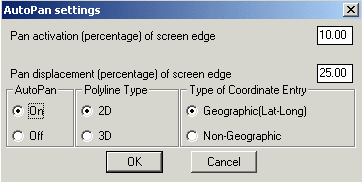
Pan activation (percentage) of screen edge: Specify the screen edge width (in percentage) at which auto-pan should activate if the picked point of the polyline happens to be within it.
Pan displacement (percentage) of screen edge: Specify the amount (in percentage) that the view should scroll when auto pan activates.
AutoPan: Specify whether the AutoPan feature is turned On or Off.
Polyline Type: Specify whether the polyline created is a 2d or 3d polyline.
Type of Coordinate Entry: Specify whether the coordinates should be Non-Geographic or Geographic units. The format of the geographic units will be in lat, long, height. For example, 33° 01' 53.8739",18° 01' 11.2246",480.0
Toolbar : Polyline Tools 
Menu : GeoTools -> Polyline Tools -> Create / Edit -> Draw linear polylines from arced polylines CmdLine : GT_LINEPOLY
CmdLine : GT_LINEPOLY
Toolbar : Polyline Tools 
Menu : GeoTools -> Polyline Tools -> Create / Edit -> Express PEDIT CmdLine : GT_XV
CmdLine : GT_XV
The Express Pedit command GT_XV allows a faster and quicker way to access some of the Pedit Edit Vertex commands like Move, Insert and Break. Additionally, it also provides extra commands like polyline statistics - slope length, horizontal projected length, X, Y and Z coordinate extents and number of vertices.
Select vertex on polyline:
Next / Previous / Move / Z / Insert / Break / Statistics / Settings / eXit <Next>:
Use Next and Previous to navigate through the vertices of the polyline. The current vertex is always shown with a cross attached to it.
Move allows specifying a new location for the current vertex.
Z allows the elevation of the current point to be set
Insert allows a new vertex to be added between the current vertex and the next vertex.
Break allows the polyline to be broken at the current point. Saves some keystrokes as compared to the Pedit command.
Statistics: Generates detailed polyline statistics
Settings allows specifying whether the Move and Insert sub-commands take the Z value from the new location or inherit it from the current vertex elevation.
An example of the statistical information is shown below:
Slope length:22719.1175 Projected horizontal length:22718.4936
Max. X-coordinate:2025286.6092 Min. X-coordinate:2010210.0148
Max. Y-coordinate:924910.0082 Min. Y-coordinate:913590.4827
Max. Z-coordinate:212.5000 Min. Z-coordinate:45.6000
Number of vertices:15
Press any key to continue.
Tip: Make sure that the entire polyline is visible on screen.
 Toolbar : Polyline Tools
Toolbar : Polyline Tools 
Menu : GeoTools -> Polyline Tools -> Vertex Management -> Place Points/Blocks along vertices CmdLine : GT_PL_PLACE
CmdLine : GT_PL_PLACE
The GT_PL_PLACE command places a point or a block at each vertex of a polyline / line. Useful for many mapping and utility applications.
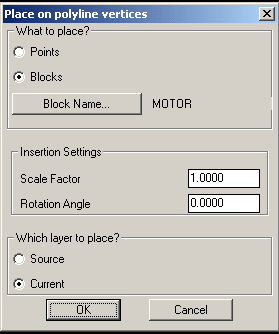
What to place?:
Points: Choose this option to place points on vertices.
Blocks: Choose this option to place blocks on vertices.
Block Name: Clicking on the button "Block Name" allows to select the block to place.
Insertion Settings:
Scale Factor: Allows to enter the required scale factor for the block.
Rotation Angle: Allows to enter the required rotation angle for the block.
Which layer to place?:
Source: Choosing this option places the block/point in source object layer.
Current: Choosing this option places the block/point in current layer.
 Toolbar : Polyline Tools
Toolbar : Polyline Tools 
Menu : GeoTools -> Polyline Tools -> Others -> Explode Splined CmdLine : GT_XPSPL
CmdLine : GT_XPSPL
The GT_XPSPL command is used to explode splined and fitted polylines. Upon selecting the splined or fitted polylines, they are exploded into their line or arc segment and then joined back to produce a "plain" polyline with line or arc segments. This command is useful to many geographic and surveying users who require a non-splined non-fitted polyline for many design purposes.
 Toolbar : Polyline Tools
Toolbar : Polyline Tools 
Menu : GeoTools -> Polyline Tools -> Others -> Zoom to Polyline CmdLine : GT_ZPOLY
CmdLine : GT_ZPOLY
The GT_ZPOLY command zooms to the extents of a picke polyline.
 Toolbar : Polyline Tools
Toolbar : Polyline Tools 
Menu : GeoTools -> Polyline Tools -> Others -> Fix line/polylines with different UCS CmdLine : GT_FIXUCS
CmdLine : GT_FIXUCS
The GT_FIXUCS command allows lines and polyline which have been created in a different (non-parallel) UCS to be brought back to the WCS at the same position.

Layer to place
Source: Creates the new polyline and places it in the layer in which it was created (source layer)
Current: Creates the new polyline and places it in the current layer
Specify: Creates the new polyline and places it in the layer specified by the user
Layer-name: Displays the name of the layer selected
Select: Clicking on Select button pops up the select layer dialog box
Delete original objects: Checking this box deletes the original source object.